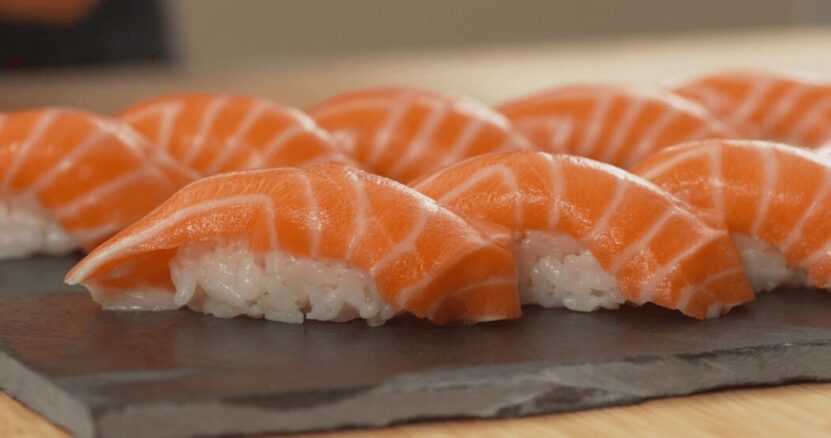Nigiri and sashimi are two classic components of Japanese cuisine that are beloved around the world. They both center around the delicate taste and texture of raw fish but are distinct in their presentation, accompaniments, and cultural significance.
This comprehensive exploration will delve into the nuanced differences, preparation techniques, cultural history, and dining etiquette associated with nigiri and sashimi, helping you to appreciate and enjoy these dishes to their fullest.
Nigiri

Nigiri is a type of sushi that consists of a slice of raw fish or other seafood placed atop an oblong mound of vinegared rice. The word “nigiri” translates to “two fingers,” which refers to the size of the rice portion that is gently pressed by the chef’s two fingers. Nigiri is often brushed with a touch of wasabi between the fish and rice and is sometimes wrapped with a thin band of nori (seaweed), particularly when the topping is something that might not sit perfectly atop the rice, like an oyster or a scallop.
One of the key characteristics of nigiri is its simplicity and emphasis on the quality and flavor of the fish. Chefs spend years perfecting their technique to shape the rice and cut the fish in a way that will enhance the taste and texture of the nigiri. The fish is typically fresh, often sourced from local fish markets, and served at room temperature to bring out its natural flavors.
Sashimi

Sashimi, in contrast, refers to thinly sliced raw meat or fish, served without rice. Common types of fish used for sashimi include salmon, tuna, mackerel, and octopus. It is often presented beautifully on a platter, garnished with shredded daikon radish, perilla leaves, or other accompaniments that enhance its visual appeal and taste. Unlike nigiri, sashimi is purely about savoring the unadulterated flavor and texture of the fish or meat.
The art of sashimi lies in the precise cutting technique, which varies depending on the type of fish and desired texture. The thickness of the slices, the angle of the cut, and the part of the fish used can all influence the flavor and mouthfeel of the sashimi. Sashimi chefs use incredibly sharp knives, known as sashimi bōchō, and each slice is a testament to their skill and dedication.
Historical Roots and Cultural Significance

The history of nigiri and sashimi is deeply rooted in Japanese culture. Sashimi has been part of Japanese cuisine for centuries, with early forms dating back to the Heian period (794-1185). It began as a simple way to enjoy fresh fish and meat, with minimal preparation to preserve the integrity of the ingredients.
Nigiri, however, is a relatively recent innovation, believed to have been developed in Tokyo (formerly Edo) in the early 19th century. It was a fast-food option for busy workers and travelers, a quick and easy way to enjoy sushi without the need for elaborate preparation. The development of nigiri coincided with improvements in rice vinegar production and refrigeration techniques, allowing chefs to enhance the flavor and preservation of the rice and fish.
Both dishes have evolved significantly over the years, influenced by changes in dietary habits, advancements in food preservation, and the globalization of Japanese cuisine. Today, they are enjoyed worldwide, with variations and innovations reflecting local tastes and ingredients.
Preparation and Ingredients

The preparation of nigiri and sashimi is an art form, demanding years of training and a deep understanding of the ingredients. For both, the quality of the fish is paramount. Chefs often visit local fish markets early in the morning to select the freshest and highest quality fish.
For nigiri, the preparation involves cooking and seasoning the rice with a mixture of rice vinegar, sugar, and salt. The rice must be cooled to room temperature before shaping it into small, oblong mounds. The fish is then sliced and pressed onto the rice, often with a dab of wasabi for added flavor.
Sashimi preparation, while not involving rice, requires precise knife skills to slice the fish. The aim is to reflect the fish’s best texture and flavor, with each type of fish cut differently to enhance its unique qualities. The chef must understand how the direction of the cut affects the taste and mouthfeel of the fish.
Dining Etiquette and Enjoyment
When enjoying nigiri and sashimi, there are certain etiquette guidelines that can enhance the dining experience. For nigiri, it is customary to eat it with your hands, turning the nigiri fish-side down to dip lightly in soy sauce. This method prevents the rice from falling apart and ensures a balanced flavor. Sashimi, on the other hand, is typically eaten with chopsticks, and it’s common to enjoy it with a small amount of soy sauce and wasabi.
In Japan, it’s traditional to eat sashimi at the beginning of the meal, as a way to appreciate the pure taste of the fish before moving on to more flavorful dishes. Nigiri is often enjoyed as part of a larger sushi meal, which may include a variety of other sushi types.
FAQs
Can I find vegetarian options for nigiri and sashimi?
Yes, there are vegetarian options for both nigiri and sashimi. For nigiri, slices of vegetables like avocado, tofu, or eggplant can be used instead of fish. Similarly, sashimi can include thinly sliced vegetables like bell peppers or cucumber, offering a similar texture and presentation without the fish.
How should I store leftover nigiri or sashimi?
Leftover nigiri and sashimi should be stored in the refrigerator as soon as possible and consumed within 24 hours. However, it’s important to note that the quality and safety of raw fish decline rapidly, and it’s always best to eat it fresh. Never leave raw fish at room temperature for more than 2 hours.
Is it possible to make nigiri or sashimi at home, and is it safe?
Yes, you can make nigiri and sashimi at home, but it’s crucial to source fresh, high-quality fish from reputable suppliers, preferably those that offer “sushi-grade” fish. Ensure that all utensils and surfaces are clean to reduce the risk of foodborne illness. Familiarize yourself with safe handling practices for raw fish before attempting.
What is the difference between the fish used in nigiri and sashimi?
There’s no inherent difference in the fish used for nigiri and sashimi, as both prioritize freshness and quality. The primary difference lies in the presentation and preparation. Nigiri features a slice of fish atop a mound of rice, while sashimi is served as standalone slices.
Are there regional variations of nigiri and sashimi within Japan?
Yes, there are regional variations of both dishes in Japan. Different regions may use local fish varieties or employ unique cutting techniques and presentations. For example, some coastal areas might specialize in certain types of seafood that are abundant locally, affecting the flavor and texture of the nigiri and sashimi served there.
How do I choose between nigiri and sashimi at a restaurant?
Choosing between nigiri and sashimi often depends on personal preference. If you prefer to enjoy the flavor of the fish with a bit of rice, opt for nigiri. If you want to savor the pure, unadulterated taste of the fish, go for sashimi. Consider trying a combination of both to experience the full range of flavors and textures.
Final Words
Nigiri and sashimi are much more than just raw fish. They are a celebration of Japanese culinary tradition, showcasing the skills of the chef and the quality of the ingredients. While they may seem similar at first glance, the differences in preparation, presentation, and taste are significant. Understanding these nuances can greatly enhance your appreciation and enjoyment of each dish.
Whether you are a longtime lover of Japanese cuisine or new to the flavors of nigiri and sashimi, the journey through their tastes and traditions is a delightful exploration of culinary artistry. As you savor each piece, remember the years of dedication and skill that have gone into its preparation, and enjoy the delicate balance of flavors and textures that make nigiri and sashimi truly special.
